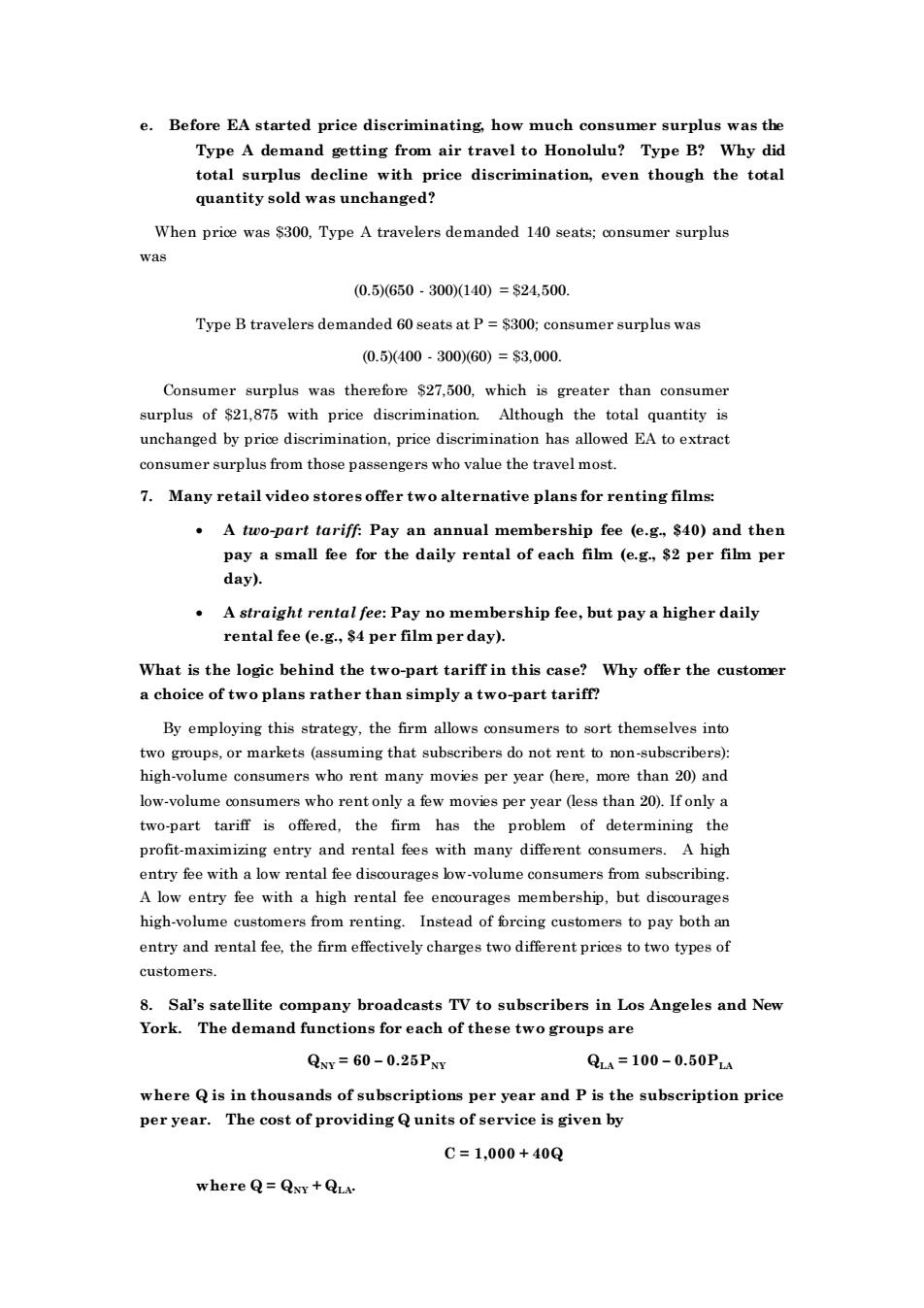正在加载图片...

e.Before EA started price discriminating how much consumer surplus was the Type A demand getting from air travel to Honolulu?Type B?Why did total surplu s decline with price discrimination,even though the total quantity sold was unchanged? When price was $300,Type A travelers demanded 140 seats;consumer surplus was (0.5)650-300140)=$24.500 Type B travelers demanded 60 seats at P=$300:consumer surplus was (0.5400.30060)=$3,000. Consumer surplus was therefore $27,500.which is greater than consumer consumer surplus from those passengers who value the travel most. 7.Many retail video stores offer two alternative plans for renting films: A two-part tariff:Pay an annual membership fee (e.g.$40)and then pay a small fee for the daily rental of each film (e.g.,$2 per film per day). A straight rental fee:Pay no membership fee,but pay a higher daily rental fee (e.g,$4 per film perday). What is the logic behind the two-part tariff in this case?Why offer the customer a choice of two plans rather than simply a two-part tariff? By employing this strategy.the firm allows onsumers to sort themselves int two groups,or markets(assuming that subecribers do not rent to non-subscribers): high-volume consumers who rent many movies per year (here,more than 20)and low-volume consumers who rent only a few movies per vear (less than 20).If only a 。A high entry fee with a low rental fee disoourages low-volume consumers from subscribing. A low entry fee with a high rental fee encourages membership,but discourages high-volume customers from renting.Instead of forcing customers to pay both an entry and fee thefirm efectively charges prices to two types of customers. 8.Sal's satellite company broadeasts TV to subseribers in Los Angeles and New York.The demand functions for each of these two groups are Qx=60-0.25Px QA=100-0.50Pa where Qis in thousands of subseriptions per year and P is the subscription price per year.The cost of providing Qunits of service is given by C=1,000+40Q where Q=Qxr+QLAe. Before EA started price discriminating, how much consumer surplus was the Type A demand getting from air travel to Honolulu? Type B? Why did total surplus decline with price discrimination, even though the total quantity sold was unchanged? When price was $300, Type A travelers demanded 140 seats; consumer surplus was (0.5)(650 - 300)(140) = $24,500. Type B travelers demanded 60 seats at P = $300; consumer surplus was (0.5)(400 - 300)(60) = $3,000. Consumer surplus was therefore $27,500, which is greater than consumer surplus of $21,875 with price discrimination. Although the total quantity is unchanged by price discrimination, price discrimination has allowed EA to extract consumer surplus from those passengers who value the travel most. 7. Many retail video stores offer two alternative plans for renting films: • A two-part tariff: Pay an annual membership fee (e.g., $40) and then pay a small fee for the daily rental of each film (e.g., $2 per film per day). • A straight rental fee: Pay no membership fee, but pay a higher daily rental fee (e.g., $4 per film per day). What is the logic behind the two-part tariff in this case? Why offer the customer a choice of two plans rather than simply a two-part tariff? By employing this strategy, the firm allows consumers to sort themselves into two groups, or markets (assuming that subscribers do not rent to non-subscribers): high-volume consumers who rent many movies per year (here, more than 20) and low-volume consumers who rent only a few movies per year (less than 20). If only a two-part tariff is offered, the firm has the problem of determining the profit-maximizing entry and rental fees with many different consumers. A high entry fee with a low rental fee discourages low-volume consumers from subscribing. A low entry fee with a high rental fee encourages membership, but discourages high-volume customers from renting. Instead of forcing customers to pay both an entry and rental fee, the firm effectively charges two different prices to two types of customers. 8. Sal’s satellite company broadcasts TV to subscribers in Los Angeles and New York. The demand functions for each of these two groups are QNY = 60 – 0.25PNY QLA = 100 – 0.50PLA where Q is in thousands of subscriptions per year and P is the subscription price per year. The cost of providing Q units of service is given by C = 1,000 + 40Q where Q = QNY + QLA